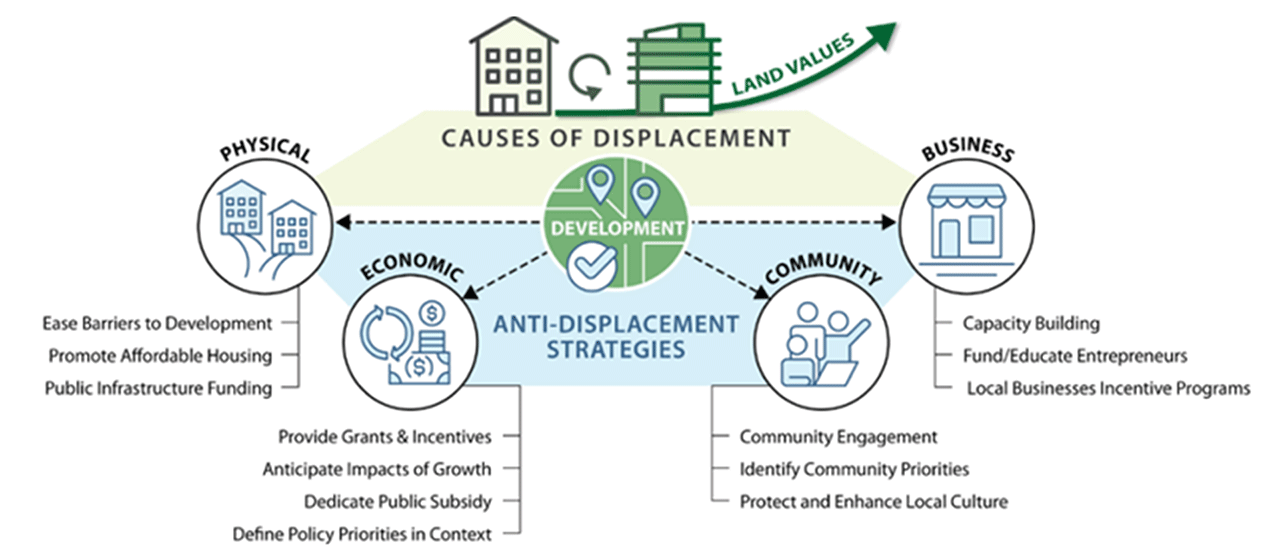
Addressing Displacement in South Logan
Maren Murphy, AICP, Senior Planner, 509.625.6500
Wednesday, January 4, 2023 at 4:25 p.m.

The South Logan Transit-Oriented Development (TOD) Project is planning for more connectivity and livability in the South Logan area for the community, businesses and organizations. The recently built STA City Line bus rapid transit route through the Logan Neighborhood presents an opportunity to create a focused community vision and policies that encourage mixed-use and walkable places close to transit. This is also part of the City’s ongoing efforts to enhance housing options, affordability and mixed-use development in areas with good access to daily needs, services and jobs.
South Logan benefits from many unique landmarks, including Gonzaga University and Mission Park, as well as its proximity to the Spokane River and downtown Spokane. One of Spokane’s first urban neighborhoods, the Logan Neighborhood has experienced many changes over time, from dominating industries like railroad and logging, to a mix of residential and commercial, to a growing university district today with major health care education centers. As South Logan continues to redevelop, it is important to ensure that current residents and local businesses are part of that growth.
What is displacement?
In recent years, the City of Spokane has invested in research on zoning reform, transit-oriented development, housing policy and anti-displacement measures. In the Spokane Housing Action Plan adopted in 2021, the City conducted a displacement risk assessment to identify areas that are at higher risk for displacement. To learn more about displacement risk assessment, read the “Understanding Housing Displacement Risk in Spokane” blog.
Housing displacement refers to instances where a household is forced or pressured to move from their home against their wishes. As high demand for homes drives up housing costs and increases pressure for redevelopment, the potential for displacement increases. Displacement in its various forms – physical, economic and cultural – has multiple, often interrelated causes and is often a consequence of growth and development. However, the impacts of displacement can be mitigated.
Housing and Anti-Displacement in South Logan
In the South Logan TOD Project, the City worked with Heartland LLC to identify strategies for housing affordability and anti-displacement measures. Transit-oriented development lends itself to more equitable development in that it focuses on directing private investment to ensure the benefits of a walkable, vibrant and affordable community is experienced by all. It is important to leverage the relationship between transportation and development to prevent displacement and ensure that new investment benefits existing residents and businesses in addition to accommodating new ones.
The focus of our analysis is on finding ways to reduce or eliminate involuntary displacement of the most vulnerable residents and businesses of the South Logan community. Given the South Logan context – certain demographic groups have been identified as most vulnerable to the pressures of displacement. Those identified as most vulnerable to displacement in South Logan are non-student, low-income residents, particularly the elderly and/or the disabled, and locally owned businesses. Lack of housing which is affordable to low- and moderate-income residents has been identified as a critical factor driving displacement of people. Similarly, lack of affordable commercial space is a key driver affecting the displacement of businesses.

Source: City of Spokane Draft Housing and Anti-Displacement Memo
Mitigating Impacts
The Draft Housing and Anti-Displacement Memo provides a “menu” of options the City could consider to address housing and anti-displacement in South Logan, with consideration for Citywide implementation. These options will be further considered in the development of the South Logan TOD subarea plan to encourage housing affordability and work to avoid displacement impacts in redevelopment. Possible strategies include:
- Adjusting development code requirements to encourage flexibility and reduce development costs.
- Public-private partnerships to address housing needs.
- Funding and supportive resources for tenants and businesses.
- Ongoing engagement with the community to ensure needs are reflected in the future vision of the South Logan area.
Visit the South Logan TOD Project page to read the Draft Housing and Anti-Displacement Memo. The City conducted a workshop with the Plan Commission on market research and anti-displacement on Nov. 9. City Council will be receiving an update on the draft memo at the upcoming Thursday, Jan. 12 Study Session. View the agenda on the City Council Study Sessions page, and tune in on City Cable 5 on the City’s website. Additional presentations and materials are available on the project page.
To receive updates on the South Logan TOD Project, sign up for email communication on the project page.
More About...
- Affordable Housing
- Biking
- Buses
- Community
- Development
- Displacement
- Engage
- Gentrification
- Gonzaga
- Homes
- Housing
- Housing Action Plan
- Housing Crisis
- Live
- Logan
- Neighborhoods
- Sidewalks
- STA
- Transit
- Transportation
- Walking
